State-of-the-art agribusiness practices
Corporate profile
CAEI´s factory started operating in 1883 as Ingenio Cristóbal Colón (Cristobal Colón Sugar Mill) and is currently part of the assets portfolio managed by Putney Capital Management, an affiliate manager of INICIA’s Energy and Industry platform. It is a benchmark company for agro industrial practices, as it produces sugar in a sustainable manner, using resources efficiently, caring for the environment, and providing its employees with the best working conditions.
Since 2006, CAEI has been developing a successful strategic plan that has introduced changes of great impact on its operations. These actions are aimed at ensuring the company’s growth, competitiveness, and sustainability. Today, after a series of investments to expand its milling capacity and after the installation of structures that strengthened its environmental management system, it is a sugar factory with leading edge technology.
Operational excellence is not the only element that distinguishes the company. CAEI produces and processes sugarcane with the highest standards in the market, using procedures that are fully certified and audited to ensure the physical integrity of its personnel and respect for the environment. Looking ahead, the company plans to expand its operations in order to continue contributing to the economic and social development of the Dominican Republic within a framework of good corporate citizenship.
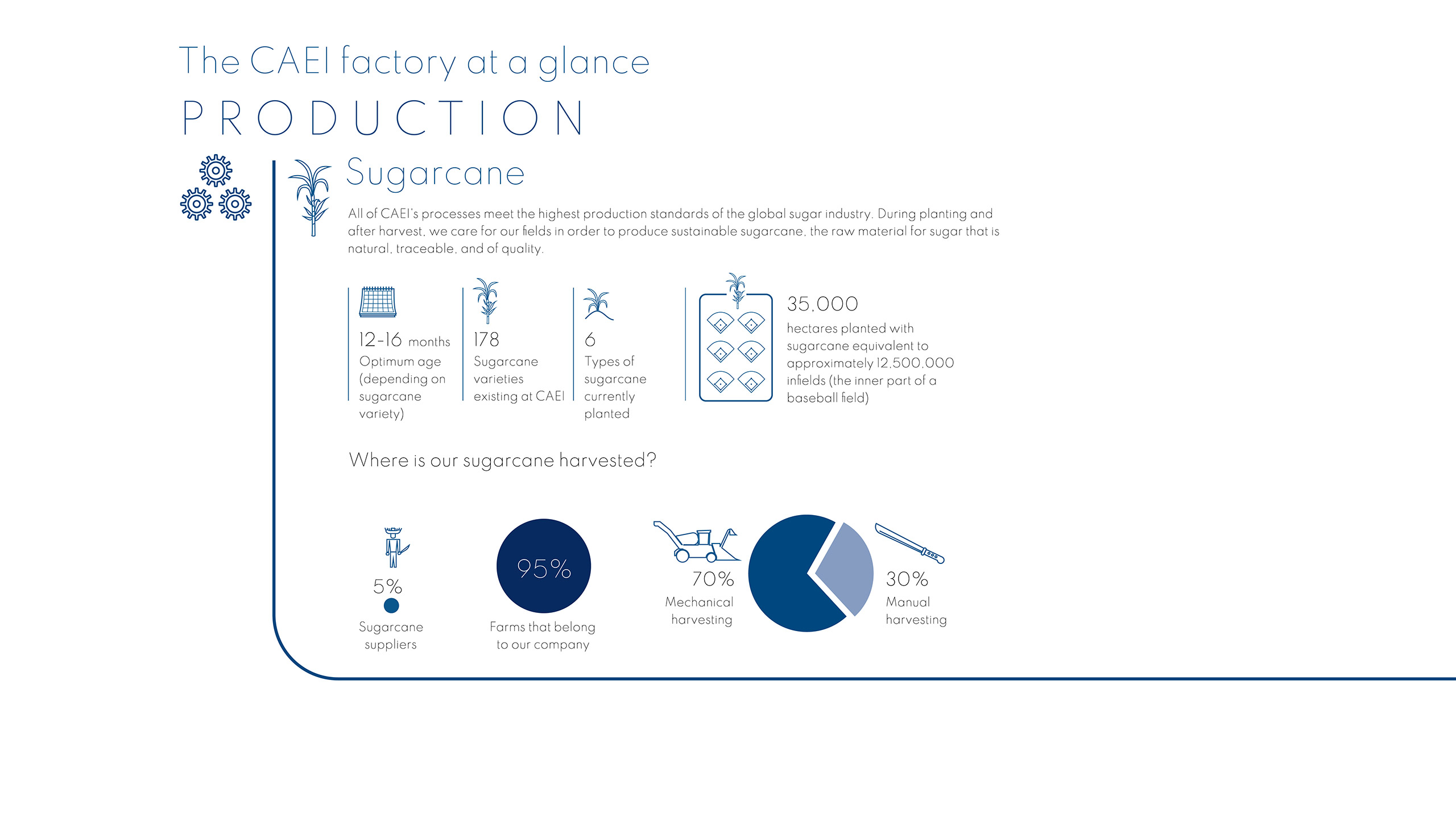
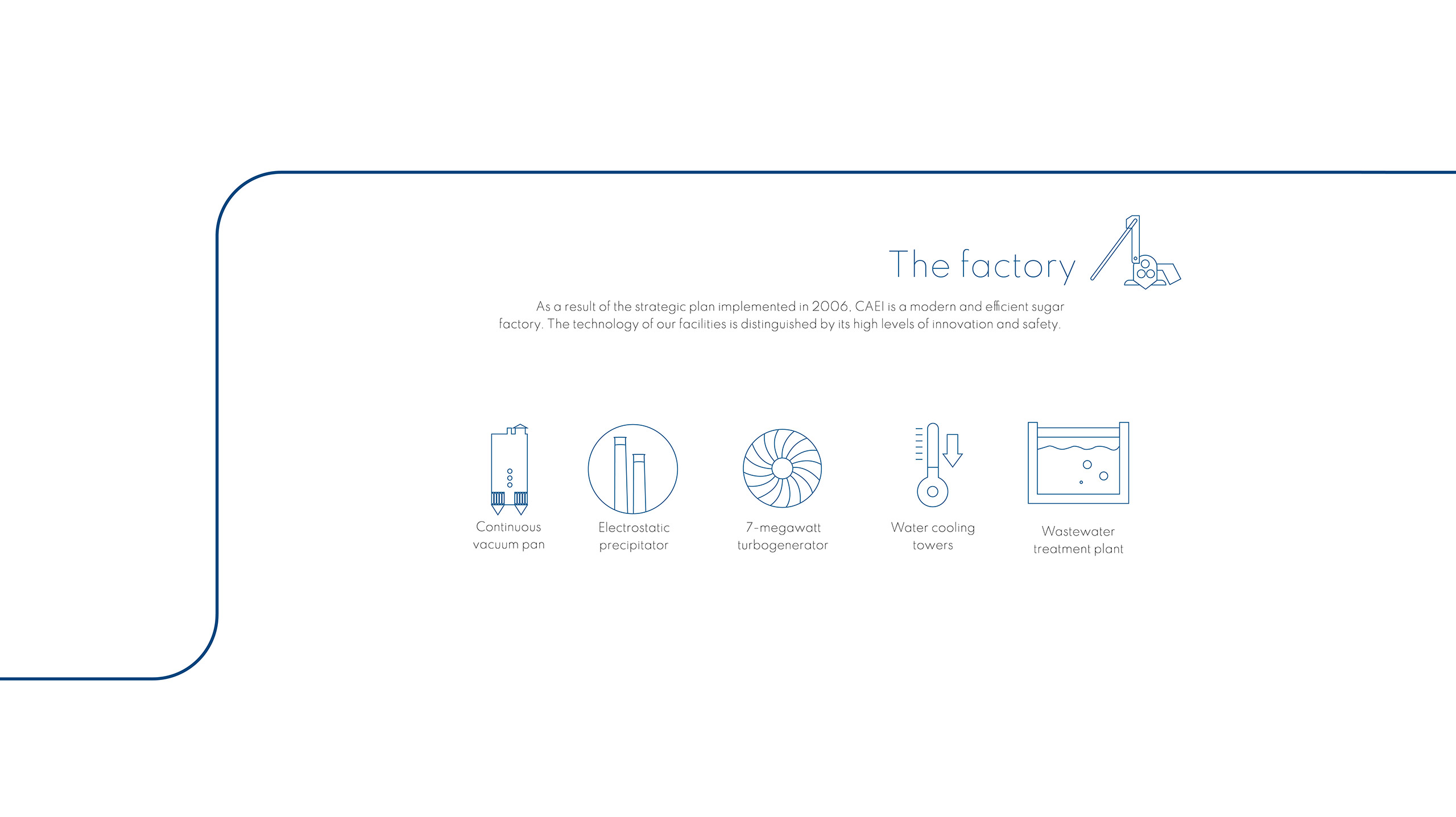
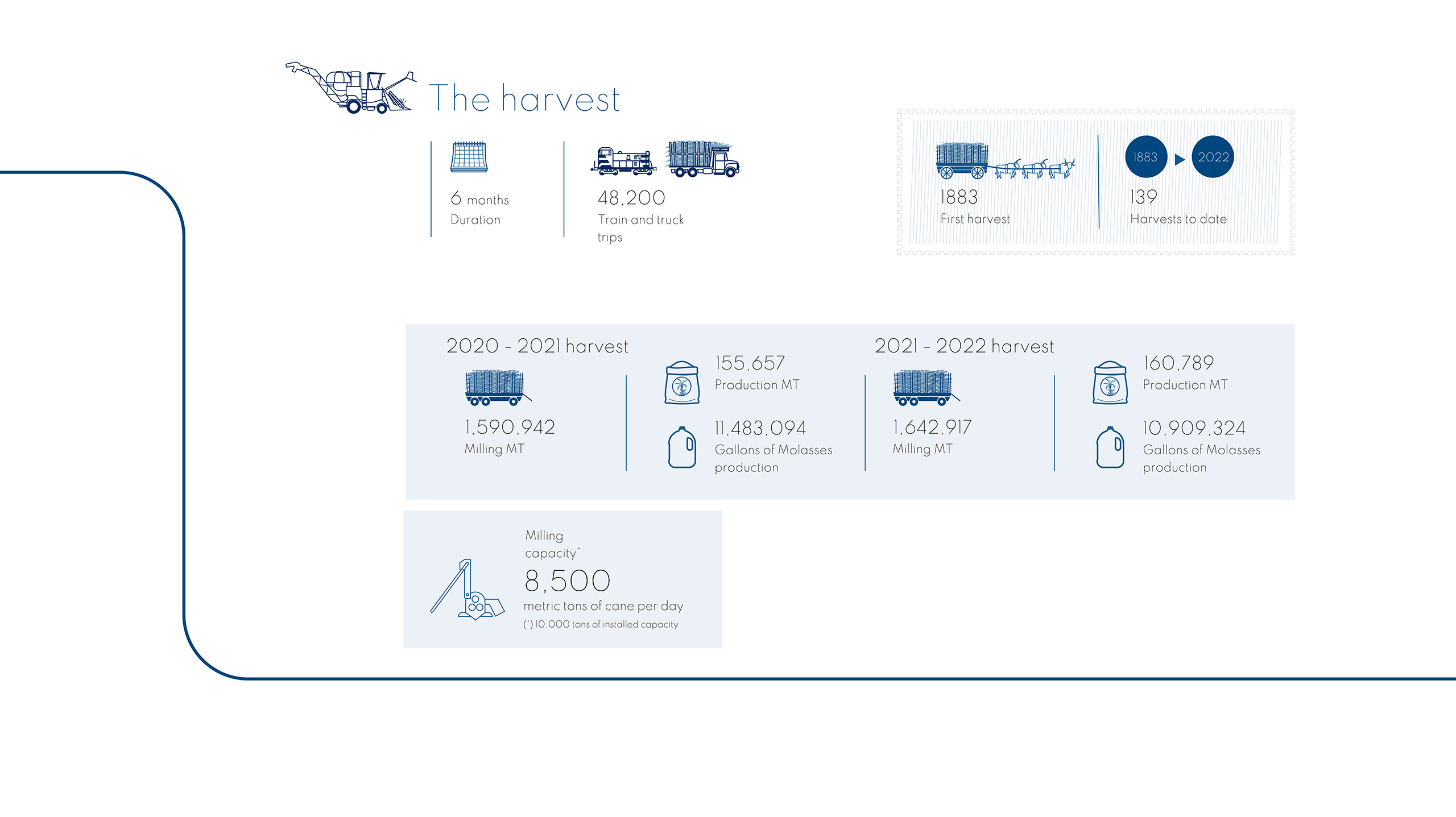
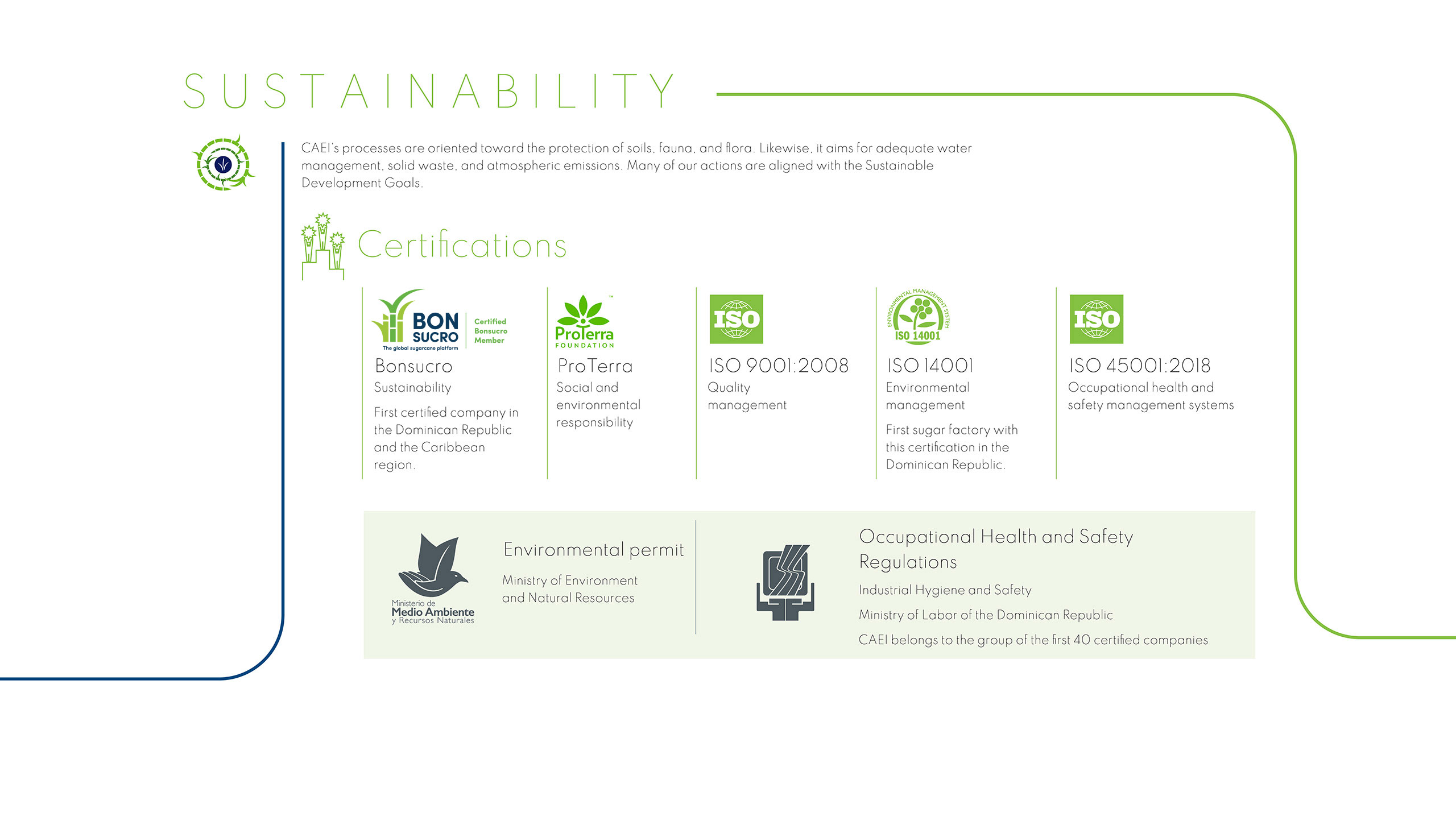
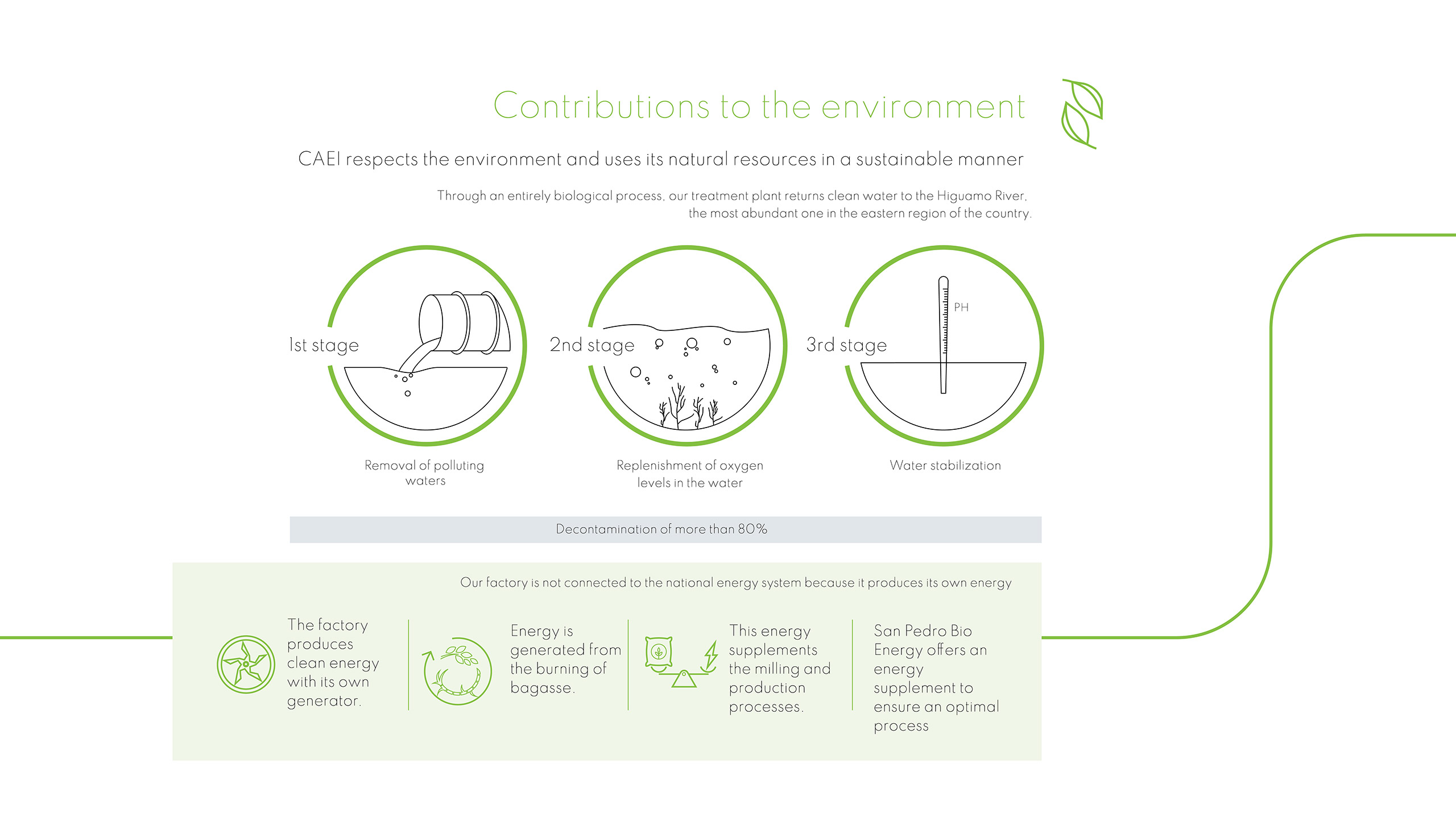
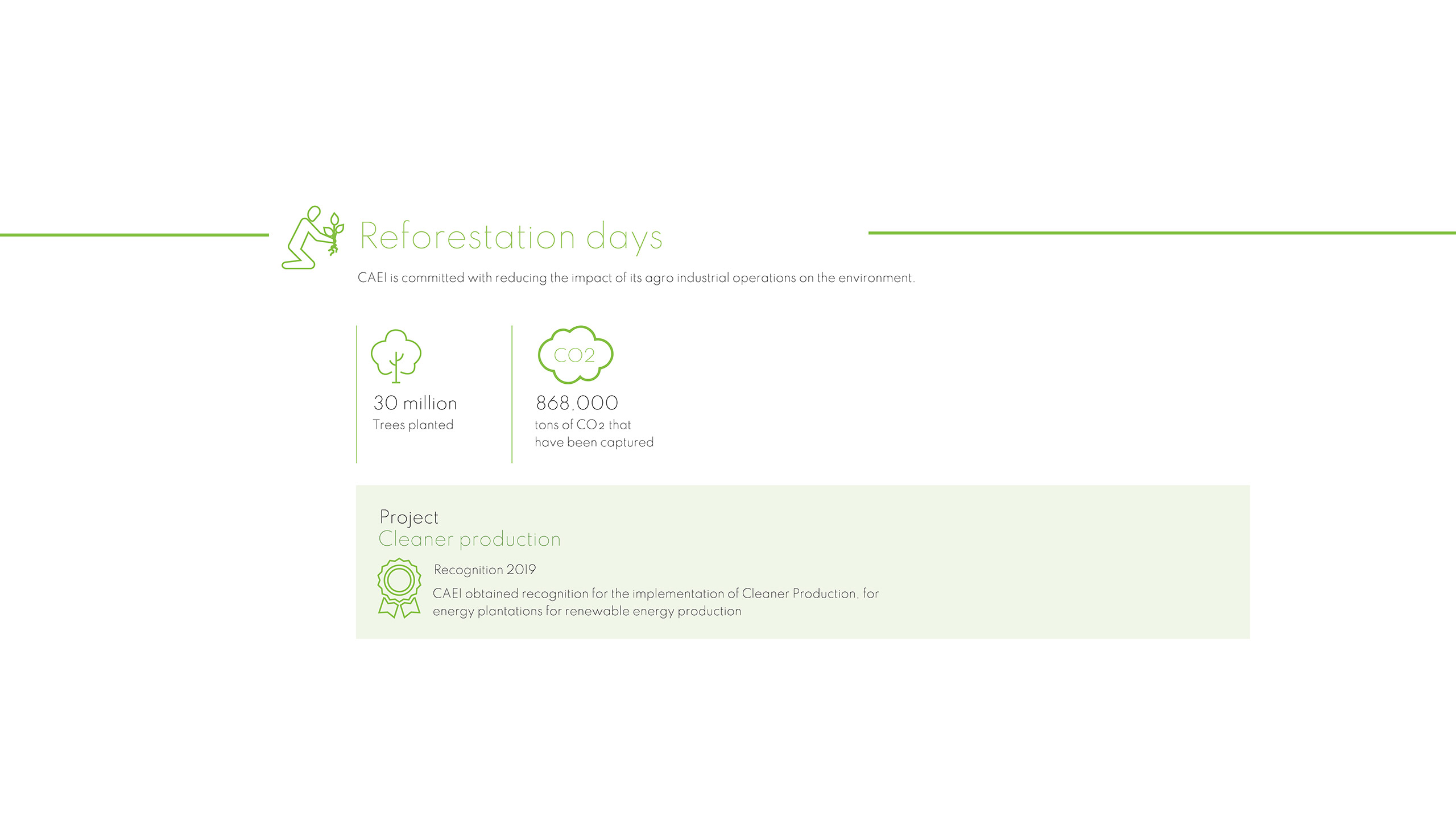
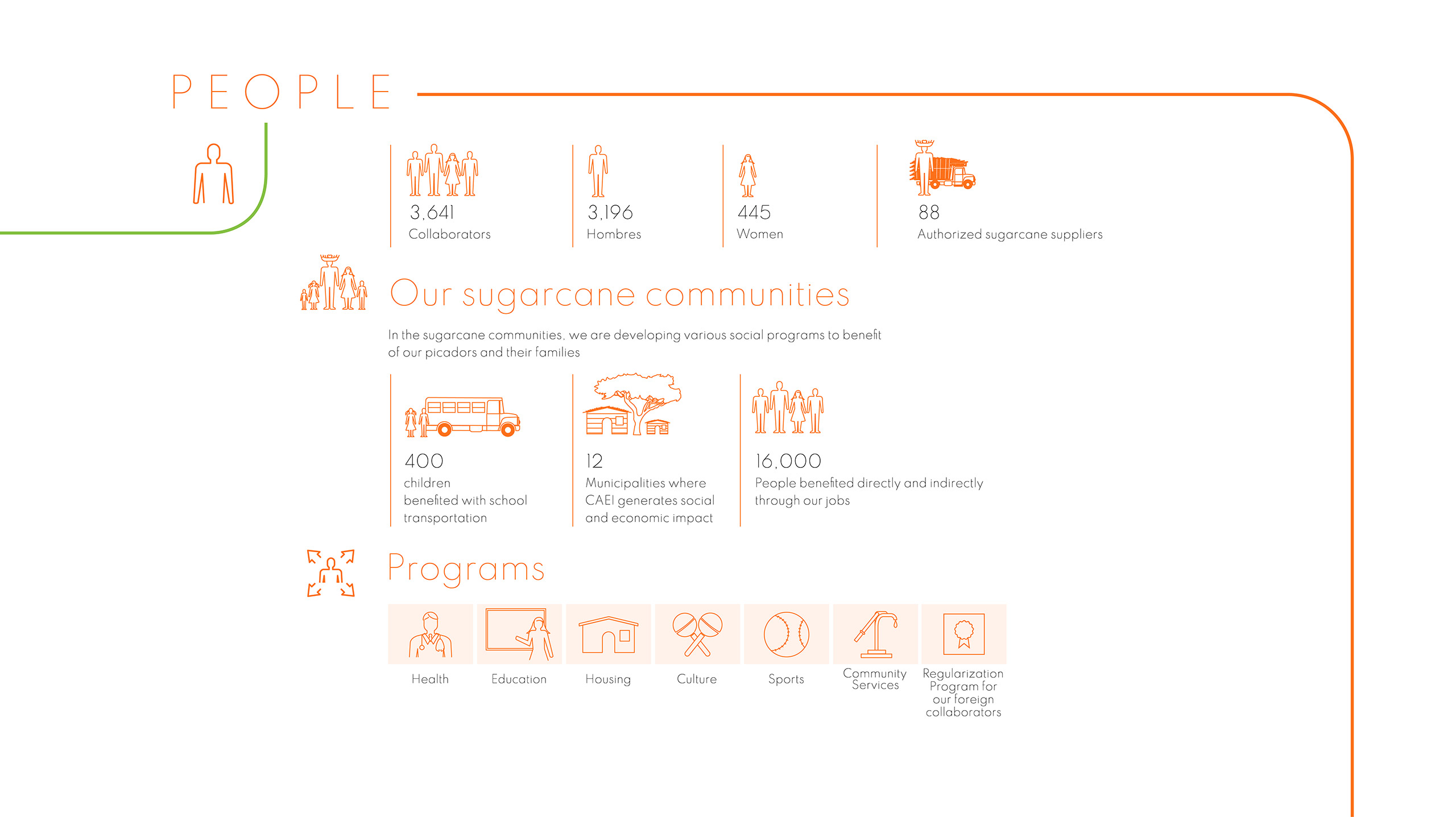
Una historia muy dulce
Cuban businessman Juan Fernández de Castro promotes the construction of the Cristóbal Colón Sugar Mill on land located on the western bank of the Higuamo River, known as El Guano and El Peñón, in the province of San Pedro de Macorís.
1882
The Cristobal Colón Sugar Mill begins its operations with a cultivation area of 1,132 hectares. A few months later, it starts operating its railroad equipment. Mr. Emilio L. de la Mola appears as owner together with Fernández de Castro.
1883
1884
The Dominican Government negotiates a Free Trade Agreement to grant the access of its sugar to the United States, but this agreement is not ratified by the American Congress. The expansion of beet sugar unleashes crisis in the international sugar industry. Many Dominican sugar mills go bankrupt and disappear.
1891
A Free Trade Agreement between the Dominican Republic and the United States enters into force, which revives the local sugar industry.
Sisters María and Mercedes Nariño acquire the Cristobal Colon Sugar Mill. The chosen hectares for sugarcane cultivation are shared between the new owners (absentees) and 16 settlers. This year's production is 70,000 quintals of sugar.
1893
1894
The United States Government assigns the Dominican Republic a 40% “ad valorem” tariff (Wilson tax) and the Free Trade Agreement between both nations is broken.
1897
The United States passes the Dingley Act to protect its factories from foreign competition. Unlike Cuba, Hawaii, the Philippines and Puerto Rico, the Dominican Republic must pay a tax of 1.68 cents per pound of sugar.
Despite low sugar prices and strong competition from the Cuban sugar industry, Cristobal Colón is one of the Dominican mills that resists the crisis while not suspending its harvest.
1900
Puerto Rican sugar is admitted to the United States with an 85% tariff reduction.
Fourteen sugar mills interrupt their operations and the owners complain to the Dominican Government about the precarious situation of the sector. For this year's harvest, the Cristobal Colón Sugar Mill hires 600 workers. The company has 2 locomotives, 11 miles of track, 250 cars, 2 horse paddocks and 100 oxen pairs of its own.
1902
The Reciprocity Treaty signed between the United States and Cuba becomes effective. In its second article, Cuba agrees to pay only 80% of the taxes on sugar imports established in the tariff of 1897.
1903
In order to compensate for war expenses, the provisional government of General Horacio Vásquez establishes a tax of 10 cents per quintal on sugar exports.
1904
President Carlos Morales Languasco increases the tax on sugar exports: 25 cents per quintal of raw sugar and 50 cents per quintal of refined sugar.
1907
The Government of Ramón Cáceres passes an Import and Export Tariff Law that frees exports of sugar and sugarcane derivatives from taxes.
1909
The United States authorizes the duty-free entry of sugar from the Philippines as long as it does not exceed 300,000 tons.
1910
Exports of sugar produced in the Dominican Republic increase to 5,590,536 dollars.
1911
In order to guarantee foreign investment in agricultural activities, the Chamber of Deputies approves a law for the partition of communal lands. Also, the Law on Agricultural Franchises, which creates a legal framework for the cultivation and processing of sugarcane.
1912
The Dominican Government passes the Law on Inscription of Territorial Property in order to stop the issuance of false title deeds in the Eastern region, where the main sugar mills of the country are located.
Four sugar mills are authorized by the Dominican Government to receive the benefits of the Law on Agricultural Franchises, among them the Cristobal Colón Sugar Mill.
1913
Sugar from Puerto Rico is admitted to the United States with a tariff reduction of 85%.
The railway line of the Cristobal Colón Sugar Mill reaches 19 kilometers in length.
1914
The United States reduces by 25% (1.256 cents per pound) the tax on imports of sugar produced in Dominican territory. The international price of sugar increases considerably due to the beginning of the First World War.
1915
A group of landowners and sugar mill owners address a public letter to President Juan Isidro Jiménez to protest the forgery of land titles in the eastern region. The country's sugar production rises to 126,058 tons.
1916
In the name of the United States, Captain Harry S. Knapp proclaims the military occupation of the Dominican Republic while the international price of sugar continues to rise.
1918
After the end of World War I, sugar reaches a record price on the international market: 23 cents per pound.
1919
The military government extends the deadline for the registration of titles with the intention of bringing order to the land where sugarcane is grown.
1920
The Dominican sugar industry produces 197,389 tons of sugar in a total extension of 47,852 hectares. The Land Registration Law is enacted to reform the previous laws on titles and rural lands.
The Compañía Anónima Cristóbal Colón, C. x A., owned by the Vicini family, purchases the 136,000 tareas sugar mill from the Nariño sisters, and on November 26 holds its first general assembly.
1921
The Cristobal Colón Sugar Mill makes an investment of 185,550.49 pesos to modernize its facilities. With this amount, two Sterling boilers, a steam pipe and a zinc-roofed steel house for the boiler are purchased.
1922
As a result of the positive margin in the sale of sugars and honeys, the profits of the sugar harvest of the Cristobal Colón Sugar Mill increase to 189,734.32 pesos.
1923
1924
Article 89 of the Constitution enacted this year prohibits the establishment of taxes on sugar exports.
1925
While the international price of sugar suffers a 40% drop, the British Beet Sugar Society obtains important subsidies. In the Dominican Republic, sugar production increases to 354,720 long tons.
Cristóbal Colón's land holdings sum up to 190,000 and the total number of head of cattle is 441. For this year's harvest, the mill employs 1,200 workers and produces 100,000 sacks of sugar.
1927
President Horacio Vásquez creates the National Sugar Commission (Comisión Nacional del Azúcar) so that the Dominican Republic becomes part of the countries seeking to stabilize the world sugar market.
Under Vicini Burgos brothers' administration, the capitalization of the Cristóbal Colón Sugar Mill almost doubles, from US$688,739 (1922) to US$1,317,441.
1930
The United States applies a new sugar tax, which rises from 2.20 to 2.50 cents per pound. Sugar from the Dominican Republic continues to receive no special treatment in the major markets.
1931
The National Congress approves a law that establishes a tax of one tenth of a cent for each gallon of molasses produced in the country.
1934
U.S. President Franklin D. Roosevelt introduces a quota system for sugar imports. However, this measure does not lighten the tariff burden on sugar-producing countries.
1935
The Dominican government amends Law 4403 to establish a differentiated treatment between locally produced sugar and imported sugar. This law also defines tax categories for the different types of sugar (refined and raw).
Dictator Rafael Leonidas Trujillo creates the Sugar Institute (Instituto del Azúcar) to distribute export quotas. Casa Vicini, owner of three sugar mills, among them the Cristobal Colón one, is assigned 42,925 metric tons, equivalent to 10% of the total quota. The sugar companies establish the Asociación Dominicana de Productores de Azúcar (Dominican Sugar Producers Association, for its acronym in Spanish).
1937
Representatives of 22 countries sign the first International Agreement for the Production and Commercialization of Sugar in London, England. The Dominican Republic is one of the signatory nations.
1940
World sugar production reaches a record of 30,209,000 metric tons. In the Dominican Republic, Trujillo's regime regains control of customs and creates new taxes on sugar and its derivatives.
1942
Dominican sugar exports to the United Kingdom decrease notably, from 172,644.09 metric tons (previous year's harvest) to 124,107.89 metric tons.
1946
As a consequence of World War II, sugar production reaches its lowest level in several important countries for the industry, among them Germany, the Philippines, and Indonesia.
1947
The Dominican sugar industry pays the Dominican State an incredible amount for sugar exports: 12,273,397 dollars. With this money, the Trujillo regime finishes paying off the country's foreign debt.
1950
Trujillo enters the sugar business by transferring the Las Pajas Sugar Mill to Villa Altagracia under the name of Catarey. On this year, the Congress enacts the Law of Industrial and Agricultural Franchises to guarantee the profitability of the dictator's sugar mills.
1951
The Río Haina Sugar Mill, owned by Trujillo and located on the western bank of the river of the same name, begins its first harvest. The Commission for the Defense of Sugar and the Promotion of Sugarcane (Comisión para la Defensa del Azúcar y el Fomento de la Caña) replaces the Sugar Institute.
1952
Trujillo buys the Monte Llano Sugar Mill in Puerto Plata from Compañía Bergantín, C. x A. The regime signs important agreements to export sugar to Canada and Great Britain.
1953
To guarantee the profitability of its sugar mills, Trujillo issues a decree dissolving the Dominican Sugar Producers Association. The country is one of the cosigners of the new International Sugar Agreement signed in London, England.
1954
A Dominican Government law grants powers to the President to establish the dates of the sugar harvest, the tonnage of sugarcane to be cut, and the tonnage of sugar to be produced by each mill.
The Trujillo regime reduces by almost 17% the production quota of the Vicini Group mills, including the Cristobal Colón one. The authorization for this year's harvest is 54,617 metric tons of sugar, compared to 65,771 metric tons in the previous one.
1955
1956
Trujillo directs another hard blow to sugar mill owners with the enactment of a law that orders the exclusive sale of honey to the Commission for the Defense of Sugar and the Promotion of Sugarcane.
With the foundation and first harvest of the Esperanza Sugar Mill, Trujillo becomes the master of the Dominican sugar industry. The Cristobal Colón Sugar Mill is one of the three factories that do not pass into his ownership.
1957
1960
As a consequence of the triumph of the Cuban Revolution, the United States cancels the importation of sugar from Cuba and assigns part of this quota to the Dominican Republic. With this decision, Dominican sugar exports set a national record: 464,000 tons (an increase of 300% with respect to the previous year).
1961
A few months after Trujillo's execution, President Joaquín Balaguer cancels all tax exemptions granted to the sugar mills that had belonged to the dictator.
The daily milling capacity of the Cristobal Colón Sugar Mill is 1,600 short tons.
1962
Sugar exports to the U.S. preferential market increase by 130% (863,439 short tons) after the withdrawal of the economic sanctions imposed by the Organization of American States (OAS), months before Trujillo's execution.
1965
By means of Law 618, the Executive Power creates the Dominican Sugar Institute (Instituto Azucarero Dominicano, or INAZUCAR, for its Spanish acronym) with the purpose of advising the President on the regulations of the national sugar policy.
1966
The State Sugar Council (Consejo Estatal del Azúcar, or CEA, for its acronym in Spanish) is constituted by Law No. 7, to replace the Dominican Republic Sugar Corporation, which had been created by Trujillo in the 1950s.
1969
The Executive Branch enacts Law No. 491 on the Colonato Azucarero, which establishes, among other matters, a system of prices between colonists and sugar mills and measures to regulate their commercial relationship.
1974
By means of Law No. 80, President Joaquín Balaguer makes the Price Stabilization Institute (Instituto de Estabilización de Precios, or INESPRE for its Spanish acronym), the exclusive distributor of sugar for domestic consumption.
1976
Sugar production reached a new local record: 1,286,946 tons. In addition, in the harvest that began this year, the colonists contributed 3,972,692 tons of sugarcane to the sugar mills of the State Sugar Council (47% of the milling).
1977
The Dominican Republic exports 1,116,585 tons of sugar as a result of an increase in international prices and the quotas established by the United States Government.
The Cristobal Colón Sugar Mill undergoes major renovation works to expand its milling capacity. At this time it only produces sugar from sugarcane grown on its own land.
1978
1982
Dominican sugar exports to the world market reach 482,258 short tons, the highest volume since the fall of Rafael Leonidas Trujillo's regime.
1986
The sugar production of the state-owned sugar mills is reduced considerably, from 554,268 metric tons to 454,463. The production of the private mills increases 13% over the previous harvest, reaching 412,409 metric tons of sugar.
1987
The National Congress grants juridical personality to the Dominican Sugar Institute through Law 27-87.
The Cristobal Colón Sugar Mill begins to sell sugar in the Dominican market. Until this time, all production was exported to the United States. Ten trucks loaded with sugar open the new commercial stage.
1990
The sugar production of the Cristobal Colón Sugar Mill is 16,700 tons per year.
1993
The Cristobal Colón Sugar Mill begins to buy the sugarcane grown and harvested by the sugar colonists.
1996
The production of the State Sugar Council´s sugar mills continues to decrease to such an extent that it experiences a 77% drop in relation to the 1986 harvest.
The combination of sugarcane harvested by the Cristóbal Colón Sugar Mill and the colonists allows this year's harvest to produce 75,000 tons of sugar.
1997
President Leonel Fernández promulgates the General Law for the Reform of Public Enterprises, which authorizes the capitalization of the State Sugar Council.
1998
Hurricane Georges destroys the sugar warehouse at the Cristóbal Colón Sugar Mill, but despite this situation, the factory produces 76,000 tons of sugar.
1999
The last harvest carried out by the State Sugar Council produces 47,227 metric tons of sugar, which is 29% less than the projected total (163,285 tons). All of the state sugar mills are leased to private corporations.
2006
The Cristóbal Colón Sugar Mill begins its transformation process with the entry of a new management generation and the vision of external consultants. The company directs its efforts towards social, environmental and economic sustainability.
In this year's harvest, the Cristóbal Colón Sugar Mill produces 83,000 tons of sugar.
2008
The Angelina, CAEI and Cristóbal Colón sugar mills begin operating under the CAEI brand name. In addition, a new strategic plan focused on social, environmental and economic compliance is implemented.
2009
With the biometric registration of agricultural operations, the Cristóbal Colón Sugar Mill begins the automation of its processes.
2010
CAEI launches its new sugar line.
2011
The Cristóbal Colón Sugar Mill starts operating a 7 megawatt turbogenerator, a cooling tower, and a wastewater treatment plant.
2012
CAEI expands production to 95,000 metric tons of sugar per year.
2013
The company collaborates with the Dominican government so that its foreign employees and their families can benefit from the national regularization plan.
2014
The factory undergoes several physical renovations in order to expand its facilities.
2015
CAEI becomes the only mill in the Dominican Republic and the Caribbean to obtain Bonsucro certification. This production standard evaluates principles that guarantee the environmental and social sustainability of all agricultural and industrial processes.
2016
The company receives ProTerra certification, another important international accreditation that evidences its commitment to the protection of human rights, good agricultural practices, social welfare and environmental preservation.
2017
Agricultural and industrial operations identified under the CAEI trademark are consolidated under a new corporate name called Consorcio Azucarero de Empresas Industriales (Sugar Consortium of Industrial Companies, or CAEI for its Spanish acronym). This year, CAEI's production reaches 141,000 tons of sugar.
2018
In this year's harvest, CAEI produces 136,032 metric tons of sugar.
2019
CAEI's annual production rises to 145,420 metric tons of sugar (6.7% more than in the previous harvest).
2020